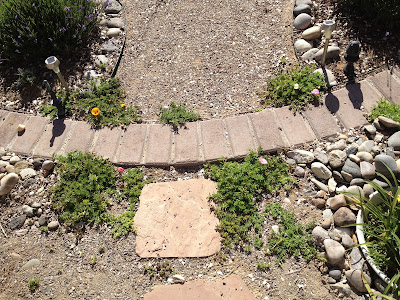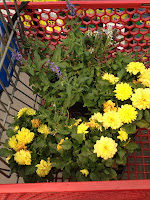Succulent Gardens
 Succulent gardens seem to be a trend this season. I've had one for a couple of years and decided to try another with different types of plants. Succulents are otherworldly to me. They always look like something from Star Trek (and actually they have been used as plants from other planets on sci-fi shows). I went to Lowe's and got a variety of different succulents. Some came as 4-packs and others were singles. I already had a nice shallow dish type planter that worked great. First I added about an inch of gravel and then the soil mix. Succulents are great because they don't need much water - in fact they'll tell you when they need watering. Just watch the 'leaves' and if they don't look plump then water! Make sure that the container drains well, standing water will cause them to rot.
Succulent gardens seem to be a trend this season. I've had one for a couple of years and decided to try another with different types of plants. Succulents are otherworldly to me. They always look like something from Star Trek (and actually they have been used as plants from other planets on sci-fi shows). I went to Lowe's and got a variety of different succulents. Some came as 4-packs and others were singles. I already had a nice shallow dish type planter that worked great. First I added about an inch of gravel and then the soil mix. Succulents are great because they don't need much water - in fact they'll tell you when they need watering. Just watch the 'leaves' and if they don't look plump then water! Make sure that the container drains well, standing water will cause them to rot.
 |
| Sedum Planter |
Before I show the
finished garden I wanted to show you what I've had going for a few years
now. This garden pot is full of different varieties of sedum. They
also have the same growing conditions as the succulents. These are
perennials and winter over pretty well if I remember to water
occasionally. As you can see I still have a bare spot that needs to be
filled in with another chartreuse plant.
There are lots of different kinds of sedum and they have really fun names: stonecrop, dragon's blood, love-restorer, baby burro's tail, and chocolate ball.
Here's my new succulent garden! It's in what used to be the seat of a vintage chair that I got for $20 (top of my budget). It originally had a real seat and it was in sad shape so I talked the price down from nearly $30. I took the bottom off and used zip ties to attach a wire basket to the rim and put the shallow dish planter inside it. I added a few rocks for visual appeal. These succulents are rather tender and will need to be brought inside during the winter, sadly this might be a death sentence for them but I'll face that later.
















































